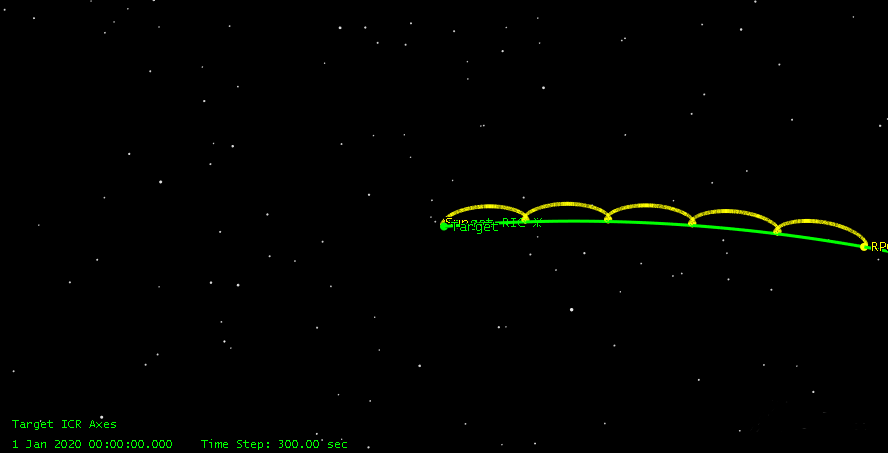Lambert Rendezvous RPO Sequence
The Lambert Rendezvous RPO sequence will perform a minimum Delta-V two-maneuver orbit rendezvous between the chase and target. Unlike the GEO to GEO Rendezvous sequence, this sequence is generic for all orbit regimes and will utilize a two-maneuver strategy to rendezvous from the chase to the target satellite. This sequence uses the Lambert Search Profile to get an initial guess for the transfer maneuvers. For some trajectories, especially longer transfers, this sequence may have difficulty converging due to the larger difference between the two-body propagation and full HPOP based propagation. In these cases, manual adjustment of the profile tolerances may be necessary. The following picture shows the minimum two Delta-V rendezvous for a chase and target satellite. This GEO-to-GEO transfer will put the transfer orbit in the GEO belt altitude every rev, which will likely upset the GEO operators with unnecessary potential conjunctions during the transfer. For this rendezvous, you should probably use the GEO_to_GEO_Rendezvous_NoLead RPO sequence.

Sequence parameters
| Option | Description |
|---|---|
| WhoAmI | Enter, as a string, the name of the current satellite. |
| LatestDepartureTime | Enter, as time units, the latest time for the first maneuver relative to the start of this sequence. |
| LatestArrivalTime | Enter, as time units, the latest time for the second maneuver relative to the start of this sequence. |
| EarliestArrivalTime | Enter, as time units, the earliest time for the second maneuver relative to the start of this sequence. |
| DeltaTime | Enter, as time units, the grid spacing for the Lambert solver to use in order to find the global minimum Delta-V for this rendezvous. This grid spacing is used to determine both the different departure times and arrival times to test. |
| MaxNumTransferRevs | Enter the maximum allowable number of revolutions for the transfer. |
| Maneuver_Type | Select the type of maneuver, Impulsive or Finite, from the shortcut menu. |
| Engine_Name | Enter, as a string, the name of the finite maneuver engine model. |